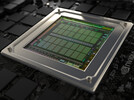NVIDIA Quadro M620 vs NVIDIA GeForce GTX 970M SLI vs NVIDIA Quadro M5000M
NVIDIA Quadro M620
► remove from comparisonThe 28nm NVIDIA Quadro M620 is a mid-range DirectX 12 (FL 11_0) and OpenGL 4.5-compatible graphics card for mobile workstations. It is a 1st generation Maxwell-based GPU built on the GM107 architecture with 512 of the 640 shader cores activated. Therefore, the GPU is not similar to any current consumer card. The Geforce GTX 950M, for example, uses the full 640 shader cores. The older Quadro M1000M offers very similar specs (same amount of shader cores and also based on the same chip but more graphics memory), but was intended for the Skylake generation. The M620 is intended for the Kaby Lake generation.
The Quadro series offers certified drivers that are optimized for stability and performance in professional applications like CAD or DCC. OpenGL performance, for example, should be significantly better compared to GeForce graphics cards of similar specifications.
Performance
Due to the smaller amount of memory, the Quadro M620 should be slightly slower than the older Quadro M1000M. However, the exact clock speeds are not known up to now. In early benchmarks we have, the M1000M is about 9 % faster than the M620 in SPECviewperf 12.
Using CUDA (Compute Capability 5.0) or OpenCL 1.2, the cores of the Quadro M620 can be used for general calculations.
Power Consumption
The power consumption of the Quadro M620 is rated for a 30 Watt TGP including the board and memory components (21.2 Watt TDP), which is 10 Watt lower than the M1000M (which offers more memory). Therefore, the card is suited for 15-inch notebooks and greater.
NVIDIA GeForce GTX 970M SLI
► remove from comparison
The NVIDIA GeForce GTX 970M SLI is a high-end DirectX 11-compatible graphics solution for laptops, consisting of two GeForce GTX 970M. Each card has a 28 nm GM204 GPU based on the Maxwell architecture, which is the same chip as found on the GTX 980M as well as several desktop cards. The clocks for the SLI-setup are usually identical to a single GTX 970M (924 MHz GPU, 1250 MHz memory).
With SLI, each card renders a single frame (AFR mode). Therefore, it may suffer from micro stuttering in low fps ranges of 30 fps. This happens because of different timespans between two frames (e.g., irregular delays between sequential frames).
Architecture
GM204 is based on Nvidia's Maxwell architecture, which replaces the previous Kepler generation. Among other changes, Nvidia have restructured the streaming multi processors (SMM) in order to increase workload and efficiency. Now each SMM contains only 128 shader units and 8 TMUs, which is noticeably less than an equivalent Kepler GPU. The GM204 features four GPCs, and each consists of four SMMs. But, in the GeForce GTX 970M, Nvidia have deactivated 6 of 16 SMMs. As a result, only 1280 shader ALUs and 80 TMUs are active. In addition, there are 48 ROPs in three clusters with 16 units each.
The memory interface has a bandwidth of 192-bits (3x 64 bit) for each of the two GPUs. Thanks to an improved compression algorithm, the connection to the GDDR5 memory should be significantly more efficient per MHz. Furthermore, the L1 (96 KB per SMM) and L2 caches (2 MB) have been significantly increased to lower the needed bandwidth. Compared to the mid-range GM107, the newer and larger GM204 has several additional features and changes. Aside from the improved polymorphic engine in the SSMs, it is also the first Nvidia chip to support DirectX 12 Feature Level 12_1.
Performance
With good driver support, SLI almost doubles the performance of a single card. The GTX 970M SLI outperforms the former GeForce GTX 880M SLI by about 10 percent and is the second fastest mobile graphics solution in late 2014. Only the significantly more expensive GTX 980M SLI offers even more 3D power and is about 30 percent faster. Nevertheless, the GTX 970M SLI is powerful enough to run even the most demanding games with highest details, AA/AF and resolutions exceeding FullHD.
Features
Most of the features are identical to the GeForce GTX 800M series. With the GTX 970M, there can be up to 4 active displays possible, but this will likely decrease due to Optimus. Displays can be connected with a maximum resolution of 3840 x 2160 pixels via DisplayPort 1.2 or HDMI 2.0 (no HDCP @ 4K). HD audio formats like Dolby True HD and DTS HD can be sent to a compatible receiver as bitstream. As with previous models, 3D Vision is not supported with Optimus.
The updated video processor VP6 supports the usual formats like H.264 and can also decode and encode H.265 with a resolution of up to 4K via the NVENC API. Several parallel streams, such as picture-in-picture in a Blu-Ray movie, are also possible.
Further features of the GTX 900M series, which are also partly supported by older cards, include Battery Boost (longer battery life during gaming), Shadowplay (recording of gaming videos up to 4K60p and 130 Mbit/s) and Gamestream (game streaming on Shield console). More information on these features are available here.
Power Consumption
The power consumption of each GeForce GTX 970M including its MXM board and memory should be similar to a GTX 870M with a specified TDP of 100 W, leading to a total TDP of about 200 W. Given the significantly higher performance, this can be considered a massive increase in performance-per-watt. Nevertheless, the SLI setup can only be used in very large and heavy gaming notebooks with powerful cooling systems. Under low load, dynamic clock rates help the GPUs to save energy.
NVIDIA Quadro M5000M
► remove from comparison
The Nvidia Quadro M5000M is a high-end, DirectX 12 (FL_12_1) and OpenGL 4.5-compatible graphics card for mobile workstations. It is a Maxwell-based GPU built on the GM204 chip with all 1536 shader cores activated and is manufactured in 28 nm at TSMC. Therefore, the GPU is similar to the consumer Nvidia GeForce GTX 980M. The Quadro M5000M is built for the Intel Skylake generation and is a successor to the Quadro K5100M (Kepler-based). The M5000M usually comes with 8 GB GDDR5 VRAM clocked at 1250 MHz (5000 MHz effective, 160 GB/s opposed to 115.2 GB/s of the K5100M).
The Quadro series offers certified drivers that are optimized for stability and performance in professional applications like CAD or DCC. OpenGL performance, for example, should be significantly better compared to GeForce graphics cards of similar specifications.
Performance
As the exact clock speed of the M5000M is still not known, we can only speculate on the performance of the card. However, it is the top model of the mobile Quadro line in 2015 and based on the same chip as the GeForce GTX 980M. Therefore, it should be clearly faster than the old Quadro K5100M.
Using CUDA (Compute Capability 5.2) or OpenCL 1.2, the cores of the Quadro M5000M can be used for general calculations.
Power Consumption
The power consumption of the Quadro M5000M is rated at the same TGP of 100 Watt as the K5100M (including the board and memory components). Therefore, the card is suited for large notebooks with 17-inch displays or greater.
| NVIDIA Quadro M620 | NVIDIA GeForce GTX 970M SLI | NVIDIA Quadro M5000M | |||||||||||||||||||||||||||||||||||||||||||||||||||||||||||||||||||||||||||||||||||||||||||||||||||||||||||||||||||||||||||||||||||||
| Quadro M Series |
|
|
| ||||||||||||||||||||||||||||||||||||||||||||||||||||||||||||||||||||||||||||||||||||||||||||||||||||||||||||||||||||||||||||||||||||
| Architecture | Maxwell | Maxwell | Maxwell | ||||||||||||||||||||||||||||||||||||||||||||||||||||||||||||||||||||||||||||||||||||||||||||||||||||||||||||||||||||||||||||||||||||
| Pipelines | 512 - unified | 2560 - unified | 1536 - unified | ||||||||||||||||||||||||||||||||||||||||||||||||||||||||||||||||||||||||||||||||||||||||||||||||||||||||||||||||||||||||||||||||||||
| Core Speed | 1018 MHz | 924 - 1038 (Boost) MHz | 962 - 1051 (Boost) MHz | ||||||||||||||||||||||||||||||||||||||||||||||||||||||||||||||||||||||||||||||||||||||||||||||||||||||||||||||||||||||||||||||||||||
| Memory Speed | 5012 MHz | 5000 MHz | 5000 MHz | ||||||||||||||||||||||||||||||||||||||||||||||||||||||||||||||||||||||||||||||||||||||||||||||||||||||||||||||||||||||||||||||||||||
| Memory Bus Width | 128 Bit | 2x 192 Bit | 256 Bit | ||||||||||||||||||||||||||||||||||||||||||||||||||||||||||||||||||||||||||||||||||||||||||||||||||||||||||||||||||||||||||||||||||||
| Memory Type | GDDR5 | GDDR5 | GDDR5 | ||||||||||||||||||||||||||||||||||||||||||||||||||||||||||||||||||||||||||||||||||||||||||||||||||||||||||||||||||||||||||||||||||||
| Max. Amount of Memory | 2048 MB | 2x 6144 MB | 8 GB | ||||||||||||||||||||||||||||||||||||||||||||||||||||||||||||||||||||||||||||||||||||||||||||||||||||||||||||||||||||||||||||||||||||
| Shared Memory | no | no | no | ||||||||||||||||||||||||||||||||||||||||||||||||||||||||||||||||||||||||||||||||||||||||||||||||||||||||||||||||||||||||||||||||||||
| API | DirectX 12 (FL 11_0), Shader 5.0, OpenGL 4.5 | DirectX 12_1, Shader 5.0 | DirectX 12_1, Shader 5.0, OpenGL 4.5 | ||||||||||||||||||||||||||||||||||||||||||||||||||||||||||||||||||||||||||||||||||||||||||||||||||||||||||||||||||||||||||||||||||||
| Power Consumption | 30 Watt | 162 Watt | 100 Watt | ||||||||||||||||||||||||||||||||||||||||||||||||||||||||||||||||||||||||||||||||||||||||||||||||||||||||||||||||||||||||||||||||||||
| technology | 28 nm | 28 nm | 28 nm | ||||||||||||||||||||||||||||||||||||||||||||||||||||||||||||||||||||||||||||||||||||||||||||||||||||||||||||||||||||||||||||||||||||
| Features | Optimus, PhysX, 3D Vision Pro, nView, Optimus | Battery Boost, GameStream, ShadowPlay, GPU Boost 2.0, Optimus, PhysX, CUDA, SLI, GeForce Experience | Optimus, PhysX, 3D Vision Pro, nView, Optimus | ||||||||||||||||||||||||||||||||||||||||||||||||||||||||||||||||||||||||||||||||||||||||||||||||||||||||||||||||||||||||||||||||||||
| Notebook Size | large | large | large | ||||||||||||||||||||||||||||||||||||||||||||||||||||||||||||||||||||||||||||||||||||||||||||||||||||||||||||||||||||||||||||||||||||
| Date of Announcement | 13.01.2017 | 07.10.2014 | 02.10.2015 | ||||||||||||||||||||||||||||||||||||||||||||||||||||||||||||||||||||||||||||||||||||||||||||||||||||||||||||||||||||||||||||||||||||
| Link to Manufacturer Page | www.nvidia.de | www.nvidia.com | |||||||||||||||||||||||||||||||||||||||||||||||||||||||||||||||||||||||||||||||||||||||||||||||||||||||||||||||||||||||||||||||||||||
| Transistors | 0 Billion | 5.2 Billion |
Benchmarks
3DM Vant. Perf. total + NVIDIA Quadro M620
specvp11 snx-01 + NVIDIA Quadro M620
specvp12 sw-03 + NVIDIA Quadro M620
Cinebench R15 OpenGL 64 Bit + NVIDIA Quadro M620
GFXBench T-Rex HD Offscreen C24Z16 + NVIDIA Quadro M620
Average Benchmarks NVIDIA Quadro M620 → 100% n=23
Average Benchmarks NVIDIA GeForce GTX 970M SLI → 234% n=23
Average Benchmarks NVIDIA Quadro M5000M → 262% n=23
* Smaller numbers mean a higher performance
1 This benchmark is not used for the average calculation
Game Benchmarks
The following benchmarks stem from our benchmarks of review laptops. The performance depends on the used graphics memory, clock rate, processor, system settings, drivers, and operating systems. So the results don't have to be representative for all laptops with this GPU. For detailed information on the benchmark results, click on the fps number.

Rocket League
2017
Doom
2016
Need for Speed 2016
2016
Hitman 2016
2016
The Division
2016
Far Cry Primal
2016
XCOM 2
2016
Rainbow Six Siege
2015
Just Cause 3
2015
Fallout 4
2015
Anno 2205
2015
FIFA 16
2015
Mad Max
2015
The Witcher 3
2015
Dirt Rally
2015
Battlefield Hardline
2015
Evolve
2015
Far Cry 4
2014
F1 2014
2014
The Evil Within
2014
Ryse: Son of Rome
2014
Alien: Isolation
2014
Fifa 15
2014
Sims 4
2014
Risen 3: Titan Lords
2014
GRID: Autosport
2014
Watch Dogs
2014
Thief
2014
Call of Duty: Ghosts
2013
Battlefield 4
2013
Total War: Rome II
2013
Saints Row IV
2013
Company of Heroes 2
2013
Metro: Last Light
2013
BioShock Infinite
2013
Tomb Raider
2013
Crysis 3
2013
Far Cry 3
2012
Hitman: Absolution
2012
Guild Wars 2
2012
Sleeping Dogs
2012
Dirt 3
2011Average Gaming NVIDIA Quadro M620 → 100%
Average Gaming 30-70 fps → 100%
Average Gaming NVIDIA GeForce GTX 970M SLI → 324%
Average Gaming 30-70 fps → 533%
Average Gaming NVIDIA Quadro M5000M → 220%
Average Gaming 30-70 fps → 260%
| NVIDIA Quadro M620 | NVIDIA GeForce GTX 970M SLI | NVIDIA Quadro M5000M | |||||||||||||||||||
|---|---|---|---|---|---|---|---|---|---|---|---|---|---|---|---|---|---|---|---|---|---|
| low | med. | high | ultra | QHD | 4K | low | med. | high | ultra | QHD | 4K | low | med. | high | ultra | QHD | 4K | ||||
| Rocket League | 127.1 | 44.9 | 31.9 | 15.7 | |||||||||||||||||
| Warhammer 40.000: Dawn of War III | 70.3 | 18.7 | |||||||||||||||||||
| Doom | 60 | 36 | 22 | 17 | |||||||||||||||||
| Rise of the Tomb Raider | 59 | 34 | 19 | 14.4 | 4.9 | 78.7 | 72.4 | 71.4 | 68 | 31.9 | |||||||||||
| Star Wars Battlefront | 110.6 | 64.3 | 28.92 | 24.37 | 199.8 | 196.9 | 127.1 | 109.3 | 40.8 | ||||||||||||
| The Witcher 3 | 53.9 | 32.83 | 18.62 | 10 | 205.1 | 144.7 | 84.8 | 47.6 | 28.4 | 155 | 123 | 67 | 38 | ||||||||
| Dirt Rally | 249 | 118.5 | 62 | 28.2 | 374.4 | 168 | 135.6 | 83.3 | 71.4 | 386 | 160 | 126 | 73 | ||||||||
| Total War: Rome II | 190.5 | 139.6 | 114.4 | 17.8 | 373 | 299 | 235 | 57 | |||||||||||||
| Company of Heroes 2 | 51.7 | 44.4 | 27.1 | 11.7 | 60 | 59 | 58 | 35 | |||||||||||||
| GRID 2 | 192.8 | 147.4 | 126 | 39.1 | 176.3 | 145.6 | 134.5 | 102.7 | |||||||||||||
| BioShock Infinite | 176.4 | 105.6 | 92.3 | 35.6 | 290.2 | 273.1 | 220 | 131 | 289 | 228 | 212 | 92 | |||||||||
| NVIDIA Quadro M620 | NVIDIA GeForce GTX 970M SLI | NVIDIA Quadro M5000M | |||||||||||||||||||
| low | med. | high | ultra | QHD | 4K | low | med. | high | ultra | QHD | 4K | low | med. | high | ultra | QHD | 4K | < 30 fps < 60 fps < 120 fps ≥ 120 fps | 3 3 5 | 1 5 3 2 | 5 1 3 1 | 7 2 | | 2 | < 30 fps < 60 fps < 120 fps ≥ 120 fps | 1 4 | 1 4 | 2 3 | 1 3 1 | | 1 2 1 | < 30 fps < 60 fps < 120 fps ≥ 120 fps | 1 5 | 1 5 | 1 1 4 | 3 3 | | |
For more games that might be playable and a list of all games and graphics cards visit our Gaming List



























